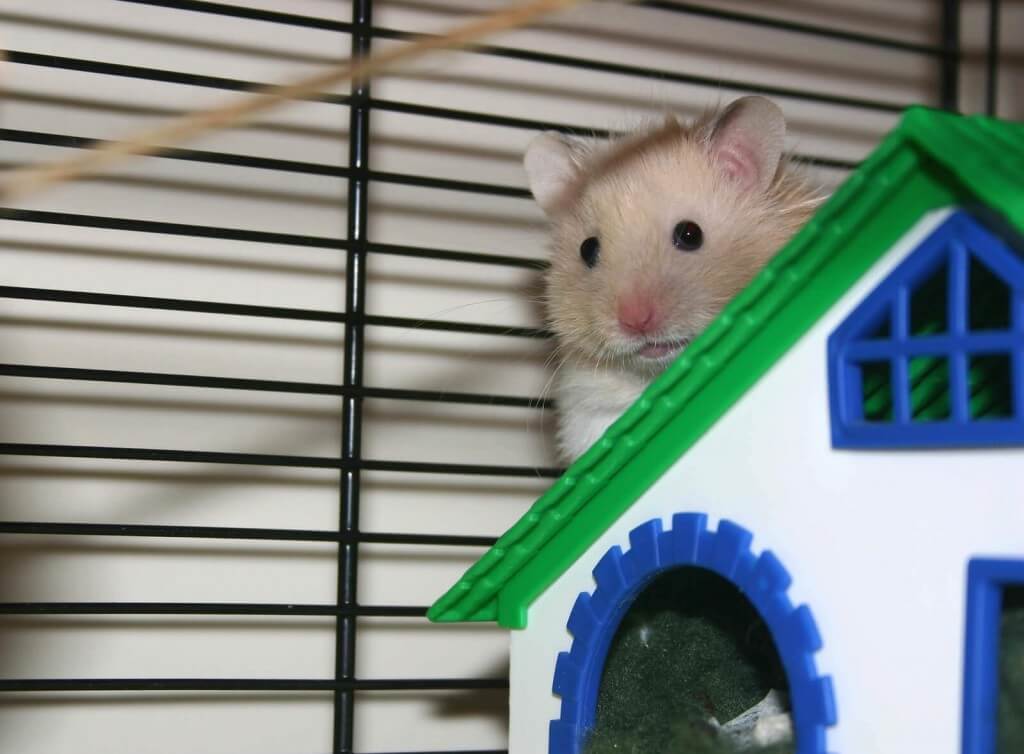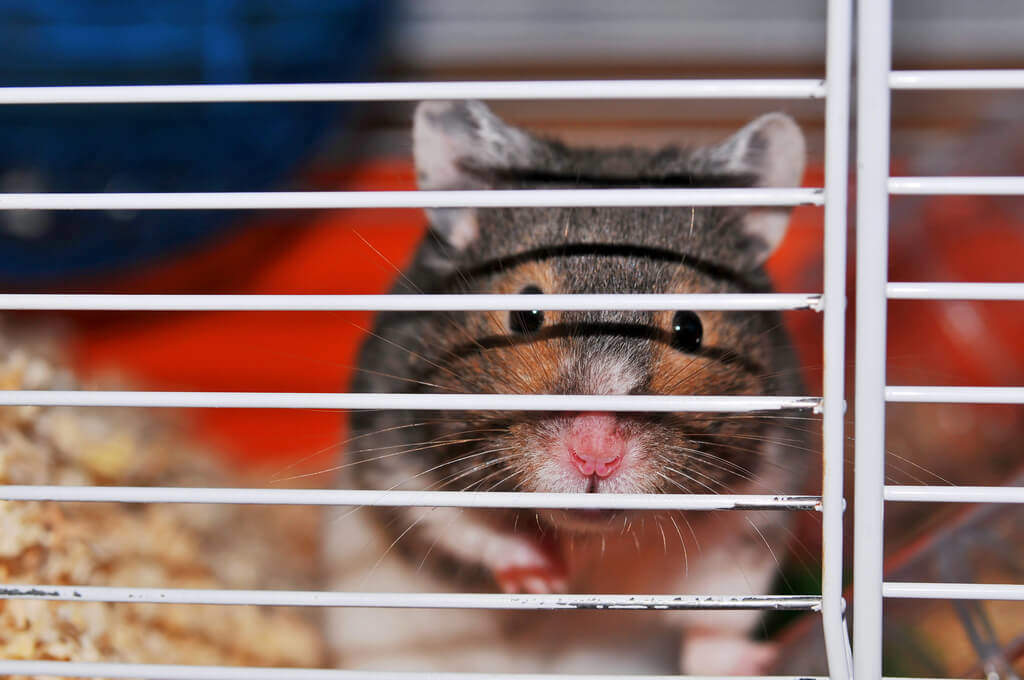Stress is a significant concern for hamsters as it can have adverse effects on their physical and mental well-being. Recognizing the signs of a stressed hamster is crucial in addressing their needs and providing appropriate care. Here, we will explore these signs in more detail, along with additional information to expand upon the topic.
Signs of a stressed hamster:
- Aggressive behavior
- Withdrawal or hiding
- Loss of appetite
- Excessive grooming
- Restlessnes
- Poor sleep habits
- Excessive burrowing
- Emitting high-pitched squeaks, growls, or loud calls
- Diarrhea or constipation

Aggressive
Aggressive behavior is one common sign of stress in hamsters. When they feel threatened or overwhelmed, they may display increased aggression towards humans or other hamsters. This can include biting, hissing, or exhibiting defensive behaviors. It’s important to approach a stressed hamster with caution and give them space to feel safe and secure.
Hiding
Another indication of stress is withdrawal or hiding. Stressed hamsters often seek refuge in their nests or burrows, avoiding interaction with their surroundings and even their caretakers. This behavior allows them to cope with the stressors they perceive in their environment. It’s important to respect their need for privacy and provide a calm and quiet space for them to retreat to.
Not Eating
Loss of appetite is a concerning sign of stress in hamsters. When stressed, they may eat significantly less or even refuse food altogether, resulting in weight loss and potential nutritional deficiencies. Monitoring their eating habits is crucial, and if you notice a prolonged decrease in appetite, it’s advisable to seek veterinary attention.
Excessive Grooming
Over-grooming or excessive grooming is another behavioral change observed in stressed hamsters. They may spend excessive time grooming themselves, leading to hair loss or bald patches. This behavior can manifest due to anxiety or as a coping mechanism. Pay close attention to their grooming habits, as excessive grooming can result in skin irritation or wounds.

Restless
Restlessness or increased activity levels are often seen in stressed hamsters. Instead of withdrawing, some hamsters become hyperactive and display restless behavior. They may engage in repetitive behaviors like pacing or circling their enclosure. These behaviors indicate their underlying stress and should be addressed by providing a calm and enriched environment.
Sleep Patterns Change
Stress can disrupt a hamster’s sleep patterns. You may notice changes in their sleep behavior, such as difficulty falling asleep, staying awake during the day (hamsters are naturally nocturnal), or sleeping excessively. These disturbances in sleep can further contribute to their overall stress levels.
Burrowing and Escape Attempts
Anxiety and stress can lead to excessive burrowing or escape attempts in hamsters. They may engage in relentless digging, trying to find a way out of their enclosure or burrowing excessively. It’s essential to ensure their habitat is escape-proof and provides appropriate outlets for their natural burrowing instincts.
Distressed Vocalization
Changes in vocalizations can be indicative of a stressed hamster. They may vocalize differently when feeling distressed, emitting high-pitched squeaks, growls, or loud distress calls. These vocalizations are their way of expressing their discomfort or anxiety.
Changes in Bowel Movements
Stress can also affect a hamster’s bowel movements, leading to changes in their elimination patterns. They may experience diarrhea or constipation as a result of stress. Monitor their droppings and check for any abnormality or inconsistency.
What to Do to Help a Stressed Out Hamster
If you notice any of these signs of stress in your hamster, it’s crucial to assess their environment and identify potential stressors. Ensure they have a suitable habitat with adequate space, appropriate bedding, hiding spots, and opportunities for mental stimulation. Minimize loud noises, sudden movements, and other stress-inducing factors in their surroundings. Maintaining a consistent and nutritious diet is also important for their overall well-being.
If the signs of stress persist or worsen despite your efforts to alleviate them, it’s advisable to consult a veterinarian with experience in small animals. They can provide further guidance, perform a thorough examination, and recommend appropriate interventions to help reduce your hamster’s stress levels.

FAQ
Are Hamster Balls Stressful?
The use of hamster balls can be a topic of debate among hamster owners and experts. While some people believe hamster balls provide exercise and enrichment, others express concerns about their potential to cause stress or harm to hamsters. It’s important to consider both perspectives and make an informed decision based on your hamster’s individual needs and preferences.
One argument against hamster balls is that they can be stressful for hamsters. The enclosed space and lack of control over their surroundings may cause anxiety in some individuals. Hamsters are naturally prey animals, and being confined in a transparent ball without the ability to hide or escape can trigger stress responses. The unfamiliar environment, different smells, and noise from the ball rolling can further contribute to their stress levels.
Additionally, hamster balls can sometimes lead to physical harm. The ball’s design can cause the hamster’s fur to get caught or tangled in the ventilation slits, resulting in injuries. There is also a risk of the hamster encountering hazardous objects or falling from heights, especially if used on uneven surfaces or near stairs.
If you choose to use a hamster ball, it’s essential to take certain precautions to minimize potential stress and risks. First, ensure that the ball is an appropriate size for your hamster, allowing them enough room to move comfortably without feeling cramped. It’s recommended to use larger balls specifically designed for Syrian hamsters, as smaller ones may not provide enough space.
Limit the duration of time your hamster spends in the ball to short intervals, typically 10-15 minutes, and closely supervise them during their time in the ball. Always provide a safe, secure, and obstacle-free environment to prevent accidents. Avoid using the ball near stairs, sharp edges, or areas where the hamster can access small spaces.
It’s important to note that not all hamsters enjoy or tolerate being in a ball. Some hamsters may show signs of distress or try to escape the ball, while others may appear indifferent. It’s crucial to observe your hamster’s behavior and body language to gauge their comfort level.
Alternative forms of exercise and enrichment, such as providing a larger, safe playpen or creating a hamster-proofed area for supervised exploration outside the cage, can be considered as alternatives to hamster balls. These alternatives allow the hamster more control over their environment and reduce the potential for stress or injury.
Ultimately, the well-being of your hamster should be the primary consideration. If you notice signs of stress or discomfort when using a hamster ball, it’s best to discontinue its use and explore other forms of exercise and enrichment that better suit your hamster’s individual needs and preferences.
Can a Hamster Die from Stress?
Yes, prolonged or severe stress can have detrimental effects on a hamster’s health and, in some cases, even lead to death. Hamsters are sensitive animals, and chronic stress can weaken their immune system, making them more susceptible to various health issues.
Stress can negatively impact a hamster’s appetite, leading to weight loss and malnutrition. It can also disrupt their sleep patterns, causing sleep deprivation and further compromising their overall well-being. Additionally, stress may result in behavioral changes such as aggression, withdrawal, or excessive grooming, which can lead to self-inflicted injuries and skin problems.
Furthermore, stress can contribute to the development of various health conditions, including gastrointestinal issues, respiratory problems, and cardiovascular disorders. Hamsters experiencing prolonged stress are also at a higher risk of developing infections, as their immune system may be compromised.
It’s crucial to identify and address the sources of stress in a hamster’s environment to prevent long-term consequences. Providing a suitable habitat, a quiet and calm setting, and opportunities for mental and physical stimulation can help reduce stress levels. Additionally, regular handling and gentle interactions can build trust and create a positive bond with your hamster, promoting their well-being.
If you notice signs of stress in your hamster, such as significant changes in behavior, appetite, or physical health, it’s important to consult a veterinarian experienced in small animal care. They can provide guidance and appropriate treatment to alleviate the stress and prevent further health complications.
Remember, a stress-free and comfortable environment is crucial for your hamster’s overall health and happiness. By being attentive to their needs and providing appropriate care, you can help ensure a long and fulfilling life for your furry friend.
Reviewed By: Tim Winter

Tim Winter has a strong affection for pets and wildlife. His years of experience caring for various types of pets has led him to share his knowledge with others on the best practices in pet care. Tim holds a Bachelor of Science from the University of Oregon School of Journalism and Communications.
